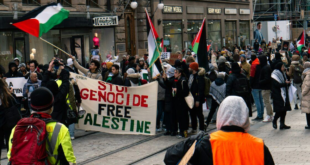(Reuters) – Lebanese leaders agreed on a unity government on Friday that gave Hezbollah and its allies a blocking minority as agreed under a deal that ended a paralyzing political conflict in the country.
Here is a chronology of Lebanon in the last 20 months.
November 11, 2006 – Five pro-Syrian Shi’ite Muslim ministers from Hezbollah and its ally, the Amal movement, resign after the collapse of talks on giving their camp more say in government.
November 21 – Industry Minister Pierre Gemayel is killed.
December 1 – Hezbollah, Amal and supporters of Christian leader Michel Aoun camp outside Prime Minister Fouad Siniora’s office in Beirut in open-ended campaign to topple the government.
June 13, 2007 – Anti-Syrian parliamentarian Walid Eido and five other people killed by a car bomb near a Beirut beach club.
September 2 – Lebanese troops seize complete control of Nahr al-Bared camp after months of fighting with Fatah al-Islam militants which kills over 420 people, including 168 soldiers.
September 19 – Car bomb in Beirut kills anti-Syrian Christian lawmaker Antoine Ghanem and six other people.
November 23 – Lahoud leaves presidential palace at end of his term, no successor has been elected. Next day Siniora says his cabinet is assuming executive powers.
December 5 – Parliament Speaker Nabih Berri says rival Lebanese leaders have agreed on General Michel Suleiman as president.
December 12 – Car bomb kills Brigadier General Francois al-Hajj, the army’s head of operations, and a bodyguard in a Christian town east of Beirut.
January 15, 2008 – Car bomb in Christian area of Beirut kills at least 3 people and wounds 16, damages a U.S. embassy car and destroys others.
January 25 – Wisam Eid, a captain in a Lebanese police intelligence unit, is killed by a bomb blast in mainly Christian east Beirut. At least five other people are killed.
May 6 – Hezbollah infuriated by government allegations it spied on Beirut airport and by cabinet’s decision to fire the head of airport security who is close to the opposition.
May 7 – Some 10 people are wounded as government supporters clash with gunmen loyal to the Hezbollah-led opposition in Beirut after followers of Hezbollah paralyze the capital.
May 8 – Hezbollah leader Sayyed Hassan Nasrallah says the government has declared war against the group after its decision to dismantle the group’s communication network.
May 9 – Hezbollah takes control of Muslim half of Beirut.
May 10 – Hezbollah fighters pull back from areas they had seized in Beirut after the army — regarded as a neutral player — overturned government measures against the group.
May 11 – Hezbollah-led forces overrun posts held by gunmen loyal to Druze leader, Walid Jumblatt, in the Aley district east of Beirut before he agrees to hand them over to the army.
May 14 – Lebanon scraps measures which sparked the fighting.
May 21 – Rival Lebanese leaders sign a deal to end 18 months of political conflict. The deal, concluded after days of Arab-mediated talks in Doha, Qatar, paves the way for parliament to elect Suleiman as president. He is sworn in on May 25.
May 28 – Suleiman appoints Siniora to head a national unity government agreed under the deal.
June 5 – French President Nicholas Sarkozy visits Beirut for five hours to urge leaders to seal reconciliation.
July 11 – Leaders agree on a unity government that gives veto power for the Hezbollah-led opposition as agreed under the Doha deal.
 Eurasia Press & News
Eurasia Press & News

